|
CONFEDERATE BREAKOUT ATTEMPT ON THE THIRD DAY
McClernand's cold and sleepy soldiers stumbled out of their makeshift
bivouacs as the first warning shots and sounds of the famous "Rebel Yell"
broke the cold morning air.
|
Just as Foote's appearance had disrupted Confederate plans that
afternoon, the unexpected victory at the water batteries confused the
Southern generals as to the urgency of leaving or fighting on. At any
rate, the troops gathered for the massive Confederate assault scheduled
for daybreak on Saturday, February 15, lumbered into position during the
winter night. Snow and wind muffled sounds of the movement. None of the
enemy detected the shifting columns. Buckner's men withdrew from their
entrenchments leaving only a single regiment of 450 men, armed with
shotguns, to face Smith's whole division. Delays proved inevitable,
however, as weary soldiers navigated slick roads. Buckner's force was
still not in position when Pillow and Johnson started their assault at
6:00 A.M. McClernand's cold and sleepy soldiers stumbled out of their
makeshift bivouacs as the first warning shots and sounds of the famous
"Rebel Yell" broke the cold morning air. The big push to flee
starvation, Yankee prison camps, and the stigma of surrender had begun.
Gideon Pillow would style it "the battle of Dover."

|
A CONFEDERATE PRISONER IS QUESTIONED DURING A UNION BIVOUAC ON
THE SNOWY BATTLEFIELD. (BL)
|
The snow, underbrush, and tactical inexperience further delayed any
quick resolution. The fighting turned into a slugfest between the
Confederates' heavy attack columns and McClernand's thin line of
defenders in the vicinity of the Forge and Wynn's Ferry Roads. By 8:00
A.M. however, the Federals were in trouble as fighting enveloped the
country lanes and ravines and blood-stained snow marked points of
contact between the two battle lines. Forrest's troopers dislodged a
stubborn Union field battery and the Confederate infantry slowly bent
McClernand's division back under heavy pressure. As the young Union
soldiers expended their ammunition they simply dropped out of line,
holding their empty cartridge boxes aloft, and began a slow withdrawal,
As one of their brigade commanders groused, "The enemy skulked behind
every hiding place, and sought refuge in the oak leaves, between which
and their uniforms there was so strong a resemblance" that his men could
not distinguish the two.
McClernand sent couriers to Lew Wallace's command post for help. But
the Hoosier general hesitated to act without Grant's instructions.
Somehow, the army commander had disappeared. Early that morning, Grant
had ridden once more to consult with the injured and humbled Foote
aboard his gunboat. Headquarters aides did not know what to do in their
leader's absence, and intervening woods hid the sounds of the unfolding
battle from the command conferees at the river. Thus, by noon, Pillow
and Johnson had carried Confederate fortunes to the brink of success.
"Our success against the right wing was complete," claimed one
Confederate observer. Avowedly, Federal defeat was caused mostly by fatigue,
supply shortages, and inept defensive moves, not by any lack of pluck or
valor. Nonetheless, McClernand's division had been beaten back from its
position.
The attackers were unable to finish their task. By early afternoon,
the relentless drive of Pillow and Johnson, now supported by Buckner,
had gained the objective. The Federals had been driven
back from the Forge Road and westward along Wynn's Ferry Road toward
Fort Henry. Two of McClernand's three front-line brigades had been
crumpled, the third forced into precipitous retreat. Still another
brigade was crushed as it rushed from
reserve. At that hour, the way out of the Fort Donelson trap was open
to the Confederates, stretched along a mile-long battle line. The
soldiers were ready; their leaders were not. During the subsequent two
hours, the Confederate generals yielded the initiative back to the
enemy.
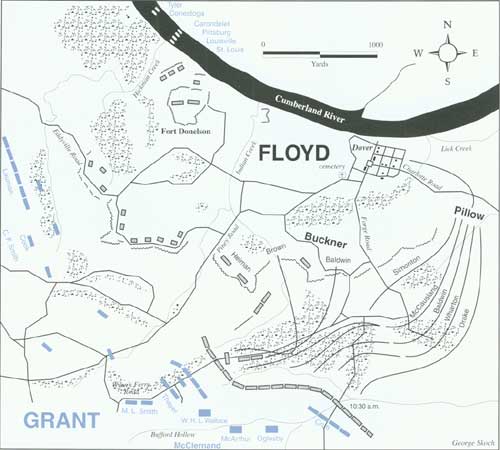
(click on image for a PDF version)
|
FORT DONELSON —
By February 14, Grant had his army in place and was waiting for the
gunboats to attack Fort Donelson, Flag Officer Foote brought his
ironclads to within 400 yards of the fort before they were forced to
withdraw. This surprised many people on both sides as some thought the
ironclads were unbeatable. This action is shown on the top of the map.
On the night of February 14, the Confederate generals decided to open an
escape route by turning and pushing the Union right flank back along the
Wynns Ferry Road. To accomplish this Confederates massed and launched an
attack east of Dover along the Charlotte Road and south of Dover near
the Forge Road. Shortly after day-break, Pillow initiated the attack
against the Union right flank, followed by Buckner's attack. Although
they offered stiff resistance, the Union right flank was pushed back
along the Wynns Ferry Road. This map shows troop positions as they were
at approximately 1:00 P.M. February 15.
|
A combination of circumstances snatched defeat from victory. Wallace
had finally taken the initiative and moved to a blocking position
astride the Wynn's Ferry Road, where he stymied the Confederate attack.
The attackers ran out of momentum and Pillow, according to his
interpretation, of the original plan, now ordered everyone back to the
trenches preparatory to evacuation. He also noticed signs of a Federal
attack on Buckner's weakly held position in the distance. Buckner,
however, raised strong objection and questioned Pillow's authority to
change the plan. The two generals haggled while their soldiers milled
around awaiting further orders. At that point, Floyd appeared, waffled
between his two subordinates, and then finally ordered all the troops
back inside the defense perimeter.
Just then, Grant returned to the field. Finally found by anxious
couriers, he had ridden hard over icy roads to reach the scene of
catastrophe brewing on his right flank. Conferring with McClernand and
Wallace, Grant sensed that the crisis in the battle, perhaps his own
career, had been reached. He saw McClernand's men "standing in knots"
talking excitedly with no officers giving any directions. He also noted
in his postwar memoirs that the soldiers had their muskets but no
ammunition although "there were tons of it close at hand." Calling out
to an aide to ride along the line with him, he shouted at the stunned
troops: "Fill your cartridge-boxes quick, and get into line; the enemy
is trying to escape and he must not be permitted to do so."
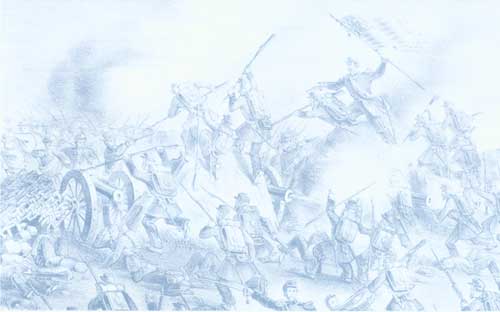
|
THIS CURRIER & IVES PRINT SHOWS THE BAYONET CHARGE AND
CAPTURE OF THE OUTER ENTRENCHMENT'S DURING THE STORMING
OF FORT DONELSON (LC)
|
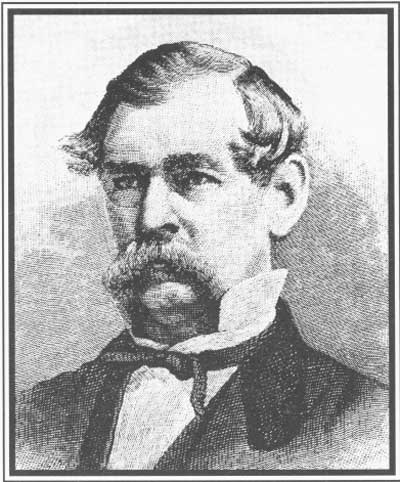
|
MAJOR GENERAL C. F. SMITH (BL)
|
This worked like a charm. Grant also discerned from prisoners what
was happening on the Confederate line and that the victorious enemy
might be just as demoralized as his own men. Whoever seized the
initiative at this point would achieve victory. Chomping down hard on an
unlit cigar, he ordered McClernand and Wallace simply: "Gentlemen, the
position on the right must be retaken." He also sent word to Foote
requesting a show of force from the gunboats. "It may secure us a
Victory," he noted, adding that "I must order a charge to save
appearances." Grant had grasped a key point. His battered battalions
only wanted "some one to give them a command." Some might be demoralized
and routed, but the majority remained ready to stand and fight.
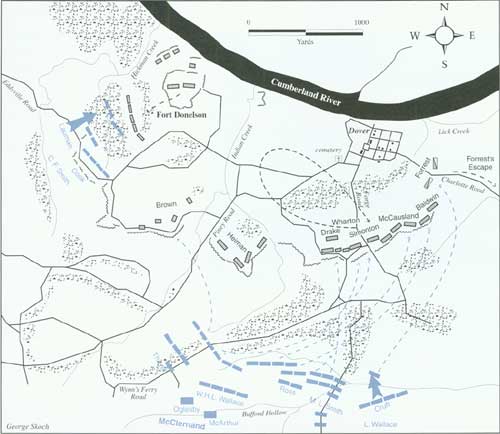
(click on image for a PDF version)
|
FORT DONELSON —
The way of escape was open, but the Confederate
generals began to argue and debate their next move. While they debated,
Union general Grant arrived. He found that his right flank had been
pushed off the battlefield. Grant correctly assessed the situation. He
concluded that it was an escape attempt. He therefore ordered the lost
ground to be retaken. He further decided that the Confederates must have
massed most of their army in an attempt to break out. Grant thought the
area opposite his left flank must be poorly defended. He ordered General
Smith to attack. By day's end, the Confederates had been pushed back
into their defenses and their right flank was in the hands of the Union
division under General Smith. Unconditional surrender was not long in
coming.
|
Grant also recognized the weakness of Buckner's trench line as he
rode over to C. F. Smith's position. He found his old friend passively
whittling on a stick beneath a tree as if nothing unusual was taking
place. Grant informed him that prisoners and the full complement of
equipment found on Rebel dead indicated a breakout attempt but that the
enemy had thrown all of their strength against McClernand. If Smith
could now assault the trenches before him, he would find little
opposition. "All has failed on the right, you must take Fort Donelson,"
Grant told Smith. Jumping to his feet, the other brigadier responded: "I
will do it!" and moved quickly to organize the assault. As the sounds of
renewed battle indicated a counterattack by Wallace and McClernand,
Smith personally led his division up the steep slope leading to
Buckner's trenches near the Eddyville Road. With battle flags fluttering
in the February breeze, the long lines of blue ascended slowly but
steadily, whipped on by Smith's bellows: "Damn you, gentlemen, I see
skulkers!" One young participant declared later that he was nearly
scared to death, "but I saw the Old Man's white mustache over his
shoulder and went on." Neither logs and brush clogging the hillside nor
the Tennesseans behind the entrenchments could cool the ardor of these
men.
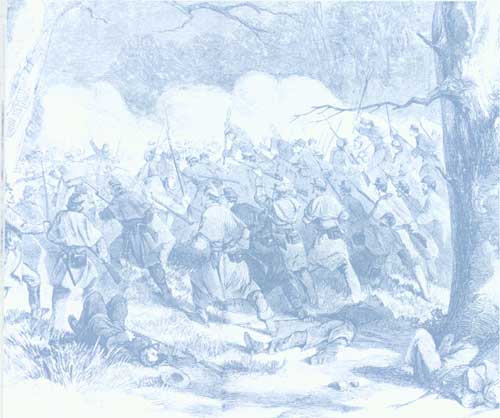
|
SMITH'S 2D IOWA REGIMENT ATTACKS FORT DONELSON'S ENTRENCHMENTS ON
FEBRUARY 15. (LC)
|
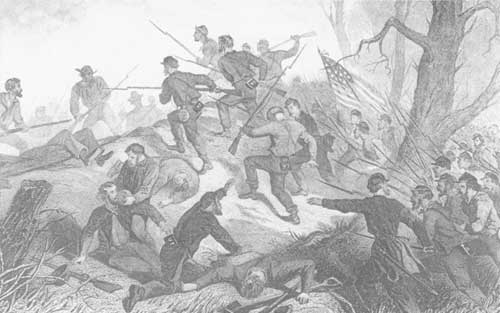
|
THE 1862 ENGRAVING DEPICTS THE CHARGE ON FORT DONELSON. (LC)
|
Smith's attackers smashed through the small Confederate holding
force from the 30th Tennessee as Corporal Voltaire P. Twombley of the 2d
Iowa led them over the works. He "took the colors after three of the
color guard had fallen . . . and although almost instantly
knocked down by a spent ball, immediately rose and bore the colors to
the end of the engagement." Thirty-three years later, the aging Hawkeye
veteran would be awarded a Medal of Honor for this deed. In a flash, the
vaunted Confederate outer defense line was breached and Smith stood on
the verge of taking the fort itself. Then, just in time, Buckner's tired
attackers returned to their sector to confront the threat. They formed a
second line of defense on an adjacent ridge, containing Smith's drive.
But they lacked the strength to retake their old trenches. Nor could
they retrieve equipment and begin evacuation. So Buckner and Smith
settled down to firing at each other across a deep ravine. By nightfall,
the fight had gone out of both sides.
Meanwhile, the battle on the Union right also stabilized. Lew
Wallace led the counterattack, in this case in loose or "zouave" order.
But Bushrod Johnson's men had spent their energy of the morning,
conducting a fighting withdrawal but incapable of throwing back the
Union attackers. Once back in their lines, they massed infantry and
artillery fire to check Wallace's drive by dusk. Therefore, the Federals
could accomplish little more than to reoccupy the ground lost during
the day's action. Caring for the casualties and reorganizing units
occupied both sides that evening. Out on the bitterly cold field,
wounded like Lieutenant James O. Churchill of the 11th Illinois could
only lie incapacitated, waiting for rescue or death. Churchill recalled
that he passed the night reciting Thomas Campbell's poem about the cold
December battle of Hohenlinden and reviewing Napoleon's return from
Moscow. He survived, but countless others did not, freezing to death
through no fault of their own. Pillow's so-called battle of Dover had
claimed 3,000 casualties for the two sides without having accomplished
much of anything as a result.
|
|
